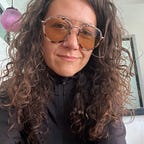Optimizing. It’s a process.
Applying UX and design sprint principles to your life — a case study.
I recently had the pleasure to help a friend entrepreneur optimize her daily routine, using a process Craig Hackey (husband and business partner) and I developed and refined over the last two years. Here’s a story of how we achieved enlightenment.
Lesley.
Lesley (not her actual name) walks in the FEWOFMANY Lab at 1:55 pm on a Monday. She knew to arrive early and to be ready to start our session at 2 pm sharp from the email I sent her a few days beforehand. Craig and I welcomed her, we all grabbed some snacks, sat down and jumped right into it.
Step 1: Draw your spirit animal.
Ha! We always start our sessions with something fun to get the creative juices flowing and get some laughs in before we get to the hard work.
We then explored Lesley’s life goals and values, and her goals for this session. We asked her to narrow down and pick her top three. Prioritizing is always a hard exercise and was her first introduction to honing into the “few of many.”
Goals.
Session goals: Build systems, better manage time, increase efficiency.
Life goals: become a philanthropist, open learning campuses across the world, have children & start a family.
Values: compassionate communication, play, love.
We then explored what Lesley wanted to optimize in her life. We laid out (brain-dumped as we call it) all of her areas of concern. To help focus and create priorities, we placed them in a quadrant of efficiency vs. fun.
Our focus.
Daily routine/time management.
In the first hour we had already narrowed down life and session goals, and where to start our focus. Time for a break.
Part deux.
After a well-deserved stretch break, we jumped into the meatiest part of our session. User maps.
We drew out three scenarios of a typical day for Lesley. There is a lot of power in seeing your life drawn out by someone else. We were able to extract the moments of joy, pain, and struggle that occur in her daily routine. Patterns started coming up, ideas and insights appeared, and excitement from an enlightened vision bubbled up. Break #2.
Finally.
After our brain-relief break, we explored how we can improve Lesley’s day to day. We worked individually and then back as a group to compile our ideas. Clusters formed, and prominent areas of improvement were naturally pointed out.
Action plan.
Areas to work on: Regulating cannabis intake, healthy eating habits, incorporating more play time in routine.
Hypothesis: By focusing on improving these areas first, her daily routine would be exponentially optimized.
Next, we dove into how to improve these areas by going through another brain-dump exercise where we explored possible solutions.
Results.
Cannabis consumption regulation:
- Get California medical cannabis recommendation.
- Visit knowledgeable dispensary to learn more about different cannabis strains, different intake solutions, and test.
- Determine dosage and time of consumption.
- Develop data collection and analysis system.
- Test, learn, do it again.
Healthier eating habits:
- Reset with a juice cleanse.
- Set eating schedule.
- Meal prepping.
- Knowing healthy eating-out options.
- Consistent grocery list and shopping schedules.
- Organize pantry and refrigerator.
- Get proper storage and to-go food containers.
- Get reminder apps.
More play in the schedule:
- Define what play is.
- Set a select number of play activities or times before the week starts.
- Reminders that play is important and that it will make her more efficient.
- Test different way to schedule mandatory play time blocks in the schedule.
- Set an accountability system.
- Develop data collection and analysis system.
- Test, learn, do it again.
And that was it.
Lesley walked in at 2 pm knowing she wanted to optimize her life without a clue where to start and walked out at 5 pm with excitement, enlightenment, and an action plan to jump-start her life optimization.
Now it’s up to Lesley to put these steps in action, test, and collect data. We will reconvene in a few weeks to learn from her experience, see what we’ve learned, and how we can improve. If Lesley finds that these first steps worked for her, then we can move onto optimizing other areas. If not, we’ll prototype again.
Final comments.
Build, measure, learn. Continually iterate. Start with the full gamut of ideas and narrow down your focus. Always align with goals and values. That’s how our process works.
If you think we can help you achieve some of your goals, or don’t even know your goals and to explore, don’t hesitate to reach out. We do this because we love helping great people who want to improve their lives.
